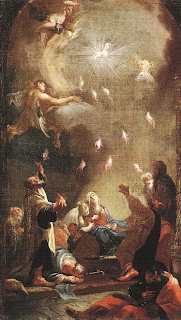
Hi again, Candace:
This is a follow-up to your earlier question concerning Marian devotion, where you wondered if the Rosary - with all those 'Hail Marys' in it - wasn't the kind of prayer Jesus warned against: that is, the 'vain repetition' He criticized regarding the religious Pharisees' praying.
It certainly appears this way to Protestants, I know. But for those who practice this particular prayer mindfully (for whom it is not rote), it isn't 'vain' repetition at all. In fact, the rhythmic repetition is a means by which the mind and spirit become more focused on what the rosary is really about: praying the gospels and walking through the life of Christ.
The rosary - like any Marian devotion - is Christocentric. The whole idea in this practice is to re-live the life of Christ in one's mind's eye from the perspective of the one who loved him the most on Earth, His mother. Side by side with her, we experience again each important occasion of the gospel story - remember what I said about narrative and story being important to
Catholics. The repeated prayers are a way to detach oneself from the world, to avoid distractions. It is a contemplative practice proven to provide a sacred space, a time set-apart, for thinking deeply and gratefully about the 'mysteries of our redemption,' as Catholics say (a thoughtfully-prayed 5-decade rosary only takes about 20 minutes, by the way). "Mysteries" have two meanings here: first, in the Pauline sense, they are holy truths now revealed, and secondly they are truths that we can understand to a point before becoming lost in wonder. I mean, who can truly grasp the terrible mystery of the Prince of Peace being crowned with thorns?
Catholics. The repeated prayers are a way to detach oneself from the world, to avoid distractions. It is a contemplative practice proven to provide a sacred space, a time set-apart, for thinking deeply and gratefully about the 'mysteries of our redemption,' as Catholics say (a thoughtfully-prayed 5-decade rosary only takes about 20 minutes, by the way). "Mysteries" have two meanings here: first, in the Pauline sense, they are holy truths now revealed, and secondly they are truths that we can understand to a point before becoming lost in wonder. I mean, who can truly grasp the terrible mystery of the Prince of Peace being crowned with thorns?
So the rosary is divided into 4 series of these 'mysteries,' that is, historical events in the gospels that reveal something particular about the saving work of God in Christ - and most of them are events that we experience as though we are standing next to Mary, seeing them through her eyes, feeling them with her heart. So when people pray the rosary properly, they aren't just repeating words over and over. They are doing this as a way to get their minds off of the everyday and to focus instead on one of these 'mysteries'. For each 'decade' of Hail Marys there is one mystery to think about, and there are five in the 'loop.'
Here are the 'mysteries' and I think you can see from the list how, if one were to pray the entire thing - all 20 decades - one would walk through the entire Gospel story and a little beyond to Acts and the hope that all believers share:
The Joyful Mysteries:
The Annunciation
The Visitation (to Elizabeth)
The Birth of Christ (Catholics don't wait til Christmas to celebrate this!)
The Presentation in the Temple (Mary obeys the Law)
The Finding of the Boy Jesus in the Temple (imagine his mother's panic!)
The Luminous Mysteries (Mysteries of Light, introduced by John Paul II, truly emphasizing the Christ-centered nature of this devotion):
The Baptism in the Jordan
The Miracle at Cana (where Mary is present and He does this to honor her)
The Preaching of the Kingdom (guess who taught Jesus much of what He knows?)
The Transfiguration
The Institution of the Eucharist
The Sorrowful Mysteries:
The Agony in the Garden
The Scourging at the Pillar
The Crowning with Thorns (what happened to the Annunciation promise that He would be king?)
The Carrying of the Cross
The Crucifixion (and we experience all this through the eyes of a sorrowing mother - how painful)
The Glorious Mysteries:
The Resurrection
The Ascension
The Gifting of the Holy Spirit at Pentecost (where Mary receives the Spirit - again!)
The Assumption (literally, 'the taking up' into heaven of Mary, a promise given to all believers as in First Thess. 4:16-17)
The Coronation of Mary as Queen (from Revelation 12, and a prefiguring of what is promised to all believers in Second Timothy 4:8)
Remember how last time I said that, if asked, "what is the gospel?", conservative Protestants would likely offer a series of propositions and proof-texts and Catholics would likely tell a story instead? This is the story they'd tell - these 20 'mysteries of our redemption.' If you understand what these are all about, then you understand God's plan of salvation - that is, the rescue plan to restore and renew and transform humanity to the full dignity and glory intended from the beginning.
I know some people are skittish about praying the "Hail Mary" at all, considering it to detract from prayer to Christ and verging on worship. I addressed this last time, I believe, but let me add two thoughts here. First, the prayer itself is Biblical, with words taken right out of the Gospel of Luke with a petition attached. Golly, if even an angel addresses her with such respect, we can, too. Secondly, if she is really the Queen Mother so highly esteemed by her kingly Son, she is worthy of our honor, too. There is nothing idolatrous in this. It's just how one properly behaves when in the presence of royalty. Moreover, I think Jesus is very pleased with us when we honor his mother. I am always pleased, as a son, when someone compliments my mother and tells me how wonderful she is. And here's one last thought: When my wife was also struggling with this issue, I asked her if she loved my mother. She said of course. I asked if she loved me any less because she loved my mother. She said no, of course not - maybe more, knowing where I came from. Well, there you go. The strange paradox, Candice, is that the closer we get to Mary, the closer we get to Jesus.







